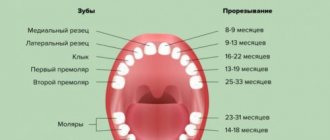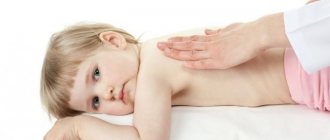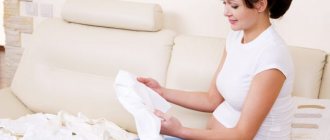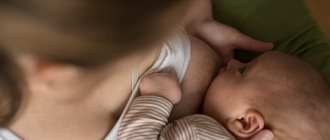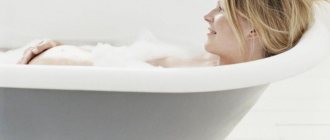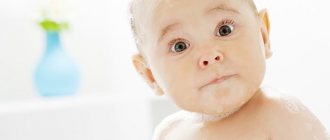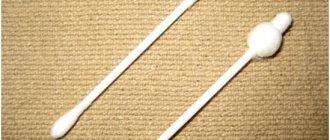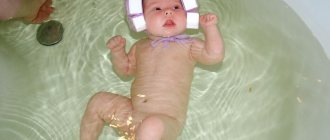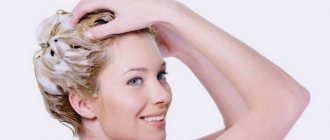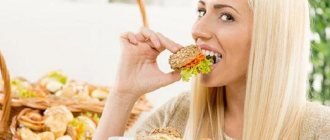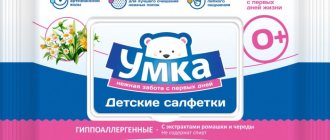Why do you need to clean the bathtub before bathing your baby?
If it is decided to bathe the baby in a shared bath, then it must be washed well before water procedures. If this is not done, then the baby may have an allergic reaction to substances deposited on its walls. Also, if a baby accidentally swallows water, he may develop a bacterial disease, since the immune system has not yet learned to resist the pathogenic microbes present in it. Residues of detergents that adults used before the baby got into the bath can also negatively affect his condition.
The bath needs to be washed if before:
- Pets were bathed in it.
- Washed or soaked laundry.
- Other family members were swimming.
- There is rust on its walls.
In general, you should try to tidy it up before each bathing of the baby.
Attention! Residues of shower gel, powders, chemical detergents - all this, once in the body of a newborn, can undermine his health.
Why does the bathtub need to be washed before bathing a baby?
The bathroom is used daily by adult family members for personal hygiene, soaking laundry, and bathing pets, if any. Limescale and soap deposits settle on the walls and are an ideal environment for the growth of bacteria. While bathing, a child may accidentally swallow water, and the newborn’s body is still developing its immune defense, making it difficult for it to resist pathogenic microbes. Komarovsky recommends taking care of the cleanliness of the bathroom in advance.
Regular rinsing will not help to completely get rid of plaque, rust, and bacteria, especially if the bathtub has been in use for a long time and its enamel is not perfectly smooth. More contaminants settle on such a surface, which are more difficult to remove.
Is it possible to clean the bathroom with chemicals?
In no case. Household cleaning products, of course, do an excellent job of removing various stains on the walls of the bathtub. However, the heavy chemicals contained in them are not completely washed off when washing the bathtub. As a result, after bathing in a bath that has been treated with a chemical, the baby may develop various rashes on the skin (as a symptom of an allergy), as well as irritation on it.
In addition, chlorine evaporation negatively affects the lungs of an infant. You can only use chemicals if the bath is very dirty. However, this should be done at least 5-6 hours before water procedures. The smell of the household product should disappear completely.
Until the baby grows up, you will have to stop using chemical compounds when cleaning the bathtub.
What cleaning products should I choose?
So that the baby does not develop health problems after bathing, and the skin remains smooth and soft, doctors, in particular Dr. Komarovsky, advise paying attention not to chemical compounds, but to methods that have long been used by the people.
Vinegar and water
To disinfect a bathtub from microbes and remove plaque, it is not necessary to buy expensive imported products; it is better to apply a composition to the surface that is easy to prepare by diluting vinegar with the same amount of ordinary water. And although there is a specific smell after cleaning, it goes away quickly. Citric acid can replace diluted vinegar.
Laundry soap
Alkali has an antibacterial and disinfecting effect. This substance is not sold in its pure form, but is present in natural laundry soap. After boiling half a bucket of water, rinse the bath. After this procedure, the plaque is easier to clean because it softens and a large number of microbes die. Lather a rag or sponge and wipe the entire surface, after which boiling water is poured in again.
Baking soda
Sodium bicarbonate is used not only for preparing dough, in folk and traditional medicine, in weight loss diets, but also for washing clothes and cleaning contaminated surfaces. Soda, as this product is called in everyday life, can be used to clean the bathtub, which is useful both before and after bathing infants who empty their bladder and during the hygiene procedure.
By mixing soda with water, a paste is obtained, which is applied to the surface for 15 minutes, and then the bath must be thoroughly washed.
Liquid baby gel
Foreign and domestic industries produce special products for bathing babies. They are made on the basis of natural materials, have hypoallergenic properties, and do not cause irritation. The bath can be washed with boiling water and baby gel without fragrances or additives.
Remaining dirt or residue:
- clean with soda;
- rinse with hot water;
- wipe with napkins.
This method of washing the bath does not pose a danger to the baby. Children's gels rarely cause irritation even to a baby's sensitive and delicate skin, but they do not cope well with germs, so the surface must be periodically cleaned with soda.
Other means
To wash the bathtub in which the baby is bathed, many parents use powder for washing baby clothes; it does not contain chemicals. To clean plaque and dirt:
- Wet the surface.
- Rub the product with a rag.
- Rinse with hot water.
Shampoos and gels that are produced for washing and treating toys are suitable for bath care. They contain fewer detergent components; rinsing after using such products should be done more thoroughly.
How to clean
Depending on the chosen cleaning product, bath treatment can take place both before and after water procedures.
Laundry soap
Before bathing a newborn, you can clean the bathtub with laundry soap. It contains alkali, which has both a cleansing and antibacterial effect.
- If you decide to wash the bathtub with this cleaning composition, then first boil 5 liters of water.
- Then rinse it. Hot water will soften the plaque and also rid the bath of germs.
- Boil the same amount of water.
- At this time, lather a sponge or rag with a cleaning agent and treat the walls of the bathtub.
- Rinse it off thoroughly with plain water.
- At the very end, rinse with boiling water.
You need to approach the choice of soap responsibly. It should not contain any additional substances that have a whitening effect.
Vinegar
You can also clean your bathtub using this composition. Parents do not bathe their babies immediately after the procedure, but several hours after it. Vinegar has a pungent odor. Its fumes can harm the lungs and respiratory tract of the baby.
- Take part of the vinegar and mix it with the same part of water.
- Pour the resulting liquid into a bottle.
- Apply cleaning agent using a spray bottle.
- Leave it for 15-20 minutes.
- Then scrub the walls of the tub with a brush or sponge.
- Rinse it off with plain water.
You can clean the bath well before bathing your baby with either acetic acid or soda.
Baking soda
It can be used immediately after bathing. It copes well with plaque, destroys bacteria and is absolutely safe for the baby. In addition, it washes off well with water.
We recommend reading: How to bathe a baby in a large bathtub
- Rinse the bathtub with boiling water the first time you use it.
- Combine water and soda so that the resulting mass resembles a paste in consistency.
- Then apply it to the walls of the bathtub.
- Leave the cleaner on it for 10-15 minutes.
- Then rinse the bathtub with plain water.
Pediatrician E. O. Komarovsky advises mothers who contact him to use soda. In his opinion, it is enough to use this product once every 7 days.
Liquid baby gel
It must be intended only for bathing newborns. It should not contain any flavors or fragrances. This product can be used before bathing the baby. To do this, apply it to a sponge and then treat the bath with it. Finally, rinse off the composition with water.
Both soap and baby gel do not fight germs and bacteria well. A few hours before using them, it is still recommended to use a stronger cleaning agent.
Safe means
Vinegar and water
You can disinfect the bath using the following method: mix vinegar and water in equal parts, apply to the surface using a spray bottle, wait 20 minutes, rinse with water. Vinegar destroys microbes and removes limescale, but has a pungent odor. It dissipates quite quickly, but is still not suitable for treating the bath immediately before bathing a child. If inhaled, vinegar fumes can harm your baby by irritating the nasopharynx and lungs.
Laundry soap
One of the natural and safe cleaning products is laundry soap. It contains alkali, which has an antibacterial and cleansing effect. You need to find a quality product without additives, avoiding special soaps that contain additional bleaching agents.
First you need to boil about 5 liters of water to rinse the bathtub before cleaning. This will help get rid of bacteria and soften plaque. Add a second portion of water. While it is heating up, soap a sponge or rag with laundry soap and thoroughly treat the surface of the bathtub. Rinse with water and rinse with boiling water again.
Baking soda
Komarovsky recommends using baking soda to clean the bathtub. It effectively fights dirt and pathogenic bacteria, is easily washed off with water and is absolutely harmless to the newborn. Apply a paste of water and soda to the surface of the bath, leave to act for 10-15 minutes, rinse with plenty of water. When cleaning for the first time, Komarovsky advises pouring 1-2 buckets of boiling water onto the surface. Then cleaning with soda once a week is sufficient. If adults haven’t bathed or washed in the bathtub all day, then it’s enough to rinse the surface with water from the shower, notes Dr. Komarovsky.
What you should know about cleaning an acrylic bathtub
It is recommended to wash it only with liquid soft compounds that do not spoil its appearance. Such means must be selected very carefully. Don’t forget after using them that the baby will be bathing in the bathtub. It should not contain flavors or various other chemical additives.
Many parents wash their bathtubs with Our Mother baby bathing gel.
The processing of an acrylic bathtub must be approached very carefully.
Bath for a newborn. And all about the first bath.
Bathtubs for bathing in a wide range on our website.
Young parents have many questions about how to properly care for their baby. It is quite understandable why parents are nervous before their baby’s first bath, because he is still so small and it seems that even a slightly careless movement can harm him. In addition, babies are quite mobile, so the child must be held firmly and at the same time gently. But once you get used to bathing your child, it will become an enjoyable daily procedure for you and your child, which you will do without thinking. At first, the child may not like bathing at all, but over time this will pass. Useful tips for buying a baby:
— You need to bathe your child in a warm room, not necessarily a bathroom.
Make sure there are no drafts. - Sponge and towels should only be used for bathing your baby, they should be kept clean and should not be used by anyone. - Choose a regular time for bathing your baby, do not bathe him when he is hungry or immediately after eating. - If you are working parents, then bathing in the evening will become a good tradition in order to spend more time with your child - this will make the bathing process more enjoyable and interesting for the child. — Before bathing your child, place all the supplies you will need nearby so that everything is at hand at the right time. It is best to bathe your baby at the same time
before one of the evening feedings or half an hour to an hour before bedtime for older babies.
The optimal air temperature in the bathroom is about 24-26°C, but not lower than 21°C. Before you start swimming, measure the water temperature with a thermometer. It should be about 37°C. Hotter water can lead to overheating of the baby, and in colder water he will simply freeze - as a result, the child may begin to be capricious, and bathing from a pleasant procedure will turn into a problem. Although experience shows that the comfortable temperature for different babies may differ. I advise you to select the temperature in such a way that your hand (bring the back of your hand to the stream of water) is comfortable, then the baby will feel good in the water. Add a bathing product to the water that is approved for use from the first days of your baby’s life. Mild liquid products are suitable for daily use. Be careful when using traditional bar soap when bathing your baby. Dermatological specialists have long been convinced that ordinary hard soap, which has proven itself as a good cleanser, can have a negative effect even on the skin of an adult, not to mention the delicate skin of children. Experts explain the disadvantages of solid soap as follows. Human skin has a protective film (hydrolipid mantle) that prevents the sun, wind, water and other external aggressive factors from affecting the skin. In babies, the protective film is very thin, because its formation ends only after the third year of life. The skin pH level of newborns is 5.5, and within a few months it changes to 6.5 (slightly acidic). It is this indicator that provides the best antimicrobial protection. Ordinary hard soap has a pH level of 10, and even special softening additives reduce it only to 7. The alkaline components it contains simply “erase” the protective film. This means that the risk of infection on sensitive baby skin increases. The baby's body tries to restore the protective layer and attracts moisture from the deep layers of the skin to the surface. This starts the process of deep drying of thin, delicate baby skin, which intensifies with each time the soap is used. This results in dry and flaky skin. Soft, soap-free foams and cream-gels effectively remove water- and fat-soluble contaminants from the surface of the baby’s skin, while maintaining the natural protective layer. Such gentle cleansing prevents irritation and dryness, and also helps maintain the protective function of delicate baby skin. The duration of bathing changes with age.
Newborn babies should bathe for only about 5 minutes, and at 3-4 months, bathing time increases to 12-15 minutes. So, let's start: - Pour the required amount of water into the bath.
Add a few drops of foam shampoo to the water and stir it. - Undress the baby and carefully lower him into the water: the back of his head should be above your left wrist (if you are right-handed), while your hand holds the baby by the shoulder farthest from you. Use your other hand to wash the baby. - Use your free hand to gently pour water over your baby. If your baby is tense or crying, smile and talk to him gently. But if the child continues to cry, it is better to stop the procedure. Perhaps tomorrow bathing will bring him much more joy. - Sometimes, during the first baths, it makes sense to immerse the baby in the bath in a diaper and unwrap it in the water, so babies are less afraid of changes in temperature. For bathing you will need:
- A baby bath (or a large bath if the child is older) - A jug or ladle for rinsing - A thermometer for water - Children's bathing foam and shampoo (preferably without tears) - A large bath towel with a hood, very convenient for older ones terry robe with hood.
Before you start swimming, you need to prepare the following things:
- Clean underwear (vest, rompers, socks, hat) - Clean cotton diaper - Diapers or swaddling pads.
— Cotton swabs, disks, balls — Hydrogen peroxide solution, 2% solution of brilliant green (brilliant green), alcohol (if the navel has not yet healed) — Baby diaper cream — Baby cream or baby oil — Hair brush For older children: — Clean panties, T-shirt, pajamas.
— Baby cream or milk, comb Apply a small amount of foam shampoo to your hand, lather and start washing. You need to wash your baby sequentially: neck, chest, stomach, arms and legs, back and only then head. Thoroughly rinse the folds of the neck, armpits, groin, elbows and knees. Don't forget to open and wash your clenched fists.
The child's head is washed daily, since babies tend to sweat a lot. Using shampoo, wash your hair 1-2 times a week. Tilt the baby's head back, holding it with your palm. Pour water over your hair from the face to the back of the head and apply and lather a few drops of foam or shampoo. Massage your scalp and then gently rinse off the foam using washing movements from your face to the back of your head.
Now you can rinse your baby with water from a jug, which should be about 1°C cooler than the water in the bath.
Wrap the baby in a towel and place him in clean diapers.
Blot (but do not wipe) first the baby's head and then the baby's body. All folds of the skin must be thoroughly dried.
Treat the umbilical wound. If the wound has not yet healed, after bathing it should be lightly blotted with a towel. Then take a cotton swab and moisten the wound generously with a 3% hydrogen peroxide solution, remove excess moisture with a clean cotton swab. Use another cotton swab dipped in a solution of brilliant green to treat the navel. Or follow your pediatrician's recommendations.
Treat all wrinkles on your baby's body with baby moisturizer or oil.
Treat the crotch folds and diaper area with baby diaper cream or powder. Do not apply cream and powder to the same areas of the skin at the same time. Put on the diaper and dress the baby. Don't forget your cap. What to bathe in?
It is very important to prepare in advance a comfortable place for the child to bathe.
To avoid an uncomfortable position while swimming, use special stands. Some designs include, in addition to bathtubs, also changing tables and shelves for accessories. These are a kind of “autonomous systems” that have everything necessary for bathing and changing a baby; they can be installed anywhere in the apartment. Anatomical bathtubs are distinguished by the fact that their bottom has a special shape that supports the child in a comfortable position. In ordinary baths, you can use stands (“slides”), nets, mattresses, which serve the same purpose and make it easier for parents to bathe their baby. When the baby begins to sit, many people use a large bathtub. To prevent him from slipping, you need a special mat, preferably with suction cups. What to bathe with? For bathing you need:
Baby foam. Look at the label: it indicates what age it is for. It’s good if there is a mark - hypoallergenic and does not contain fragrances or dyes. Baby shampoo (however, you can also wash your hair with baby foam). Baby oil (if your head is covered with crusts, grease them with oil; when they soften, brush them with a baby hair brush). Baby soap (makes sense in extreme cases when dirt is visible to the naked eye).
Soft mitten or natural sponge.
Bath toys to
a) the child was not bored and
b) he was distracted and thrashed his feet less in the water. How to hold it? The most important thing is to keep your child in the water so that neither you nor he is afraid. If you feel insecure, it’s better not to start - the child will also feel in danger and will be capricious. The head and shoulders should rest on your forearm, and your hand should be under the baby's armpit (unless you are using accessories to support the baby in the bath). Mandatory rules:
1. Until the child’s belly button heals (about two weeks of age), either you don’t need to bathe him at all, or bathe him in boiled water with the addition of a solution of potassium permanganate (the water should be slightly pink in color).
2. Never leave small children unattended in the bathtub, even after they have learned to sit, stand or walk. 3. If the baby is lying on the changing table, do not be distracted, do not turn away or move away from him. Children are very fidgety creatures. I would like to keep them intact. 4. Make sure there are no drafts. 5. Try not to pour water on your child's face (children hate this). It is better to wipe your face separately. Washing and cleaning the nose.
In the morning before feeding, you need to use a piece of cotton wool (it’s most convenient to roll out more cotton balls in advance or buy ready-made ones) to wash the baby’s face with boiled water at room temperature and carefully dry with a clean napkin or handkerchief.
Please note that you need to wash your eyes from the outer edge of the eye to the inner edge and to the nose, each eye separately, with one ball only once, and if you need to wash it additionally, take another clean ball. If the eyes fester or become watery, wash the healthy eye first, then the diseased one. Dry the eyes with dry pieces of cotton wool or disks, separate for each eye, or with a soft, clean napkin. To clear your child’s nose, you must first drop one drop of saline solution into each nostril (for example, Aqualor, Aquamaris, Salin). You can even use regular pharmaceutical saline solution. It is not recommended to prepare saline solutions for children at home - they are prepared in distilled sterile water with precise adherence to proportions and hygiene rules; this cannot be achieved at home. So, we drip 2-4 drops into each nostril and wait (you can play fetch for now), after a few minutes the crusts soften and are easily removed with a cotton swab (and never a stick!) dipped in the same solution. After instillation, some children begin to sneeze, sneezing out most of the crusts on their own - all you have to do is remove the remaining ones with a flagellum. Carefully screw the flagellum into the nasal passage 1-1.5 cm, turn it slightly and remove it. Previously, there were recommendations to clean with nossterile oil, but recently this has been abandoned. The oil disrupts the functioning of the ciliated epithelium of the nasal mucosa, which complicates its normal functioning and can even cause swelling of the mucous membrane. We clean our ears.
It is necessary to wash the child's ears very carefully so as not to pour water into the ear canal. This is done with a cotton ball soaked in boiled water and wrung out. Each ear has its own separate ball - do not forget the area behind the ears, desquamated epithelium often accumulates there, which causes irritation. If a lot of wax accumulates in the child’s ear canal, you need to carefully clean it out with a flagellum (again, not with a stick!). But the flagellum should not be inserted deeply, so as not to damage the delicate membranes of the ear canal.
PS You can purchase baths for children on our website.
Reviews
Ekaterina: “Once I washed an acrylic bathtub using a regular cleaning product. Scratches appeared on it immediately after that. This really upset me because it was new. Now I only wash her with citric acid or gel for newborns.”
Larisa: “We bathe only in a clean bath. All family members wash her after themselves with baby liquid soap.”
Elena: “When Andrei was little, we washed the bathtub with vinegar several times a week. This cleaning agent is good because it perfectly fights germs and bacteria, eliminates limescale deposits accumulated on the surface of the bathtub, but after treatment there are no traces left on it. Another advantage is that it does not produce a chemical reaction dangerous to the health of the newborn.”
So, you need to approach the treatment of the bath before bathing your baby very responsibly. It doesn’t matter what cleaning agent you use: soda, vinegar or laundry soap. The main thing is that any of them is then thoroughly washed off with water. Many babies love water procedures, and they are also good for their health. Don't neglect cleaning your bathtub. Give your little ones a clean bath and keep them happy and healthy.
What to use?
Before bathing, the bath is cleaned with various gentle products.
Baking soda
You can use regular and safe baking soda to clean your bathtub . It effectively removes dirt and gets rid of pathogenic bacteria.
- A paste of water and soda (1 glass of soda per 0.5 liters of water) is applied to the entire surface of the bath and left to act.
- After 10-15 minutes, wash off with plenty of water.
- Additionally, when cleaning the bathtub for the first time, pour 1-2 buckets of boiling water onto the surface.
In the future, it is enough to clean with soda once a week.
Soda acts as an abrasive material. It can scratch the coating, which is why it is not suitable for cleaning acrylic surfaces.
Vinegar
perfectly destroys germs and limescale .
- For disinfection, mix vinegar and water in equal parts.
- Next, apply it to the surface using a sprayer.
- After 20 minutes, rinse with water.
There is one drawback - a specific pungent odor. But it fades quickly.
This method is used if it is possible to prepare the bath 2-3 hours in advance. It is not recommended to use the bathtub for bathing immediately after cleaning.
If inhaled, vinegar fumes can harm your baby by irritating the nasopharynx and lungs.
Liquid soap or gel
To clean the bathtub, you can use liquid soap or gel intended for babies . They should not contain flavors or fragrances. The mechanism for washing a bathtub is simple: apply the product to a sponge and treat the bathtub. Then you just have to wash it off
It must be remembered that such bath cleaning is not effective against germs and bacteria.
A few hours before using the bath, you should use a stronger cleanser.
Laundry soap
Laundry soap has active cleaning properties . It is a natural and safe remedy. It contains alkali, which has an antibacterial and cleansing effect.
- The bath is first doused with boiling water to get rid of bacteria and soften plaque. To do this, boil 5 liters of water in advance.
- Then the sponge is soaped with laundry soap and the surface of the bath is thoroughly treated.
- Then wash off the foam with water and pour over a second portion of boiling water.
Other means
For cleaning you can use mustard powder and lemon juice.
Apply one or another ingredient to the surface of the bath and wash off after 10 minutes.
also use citric acid . Mix citric acid (crystals) and water proportionally 1:10, sprinkle on the dirt, leave for 20 minutes. Then rinse with running water.
